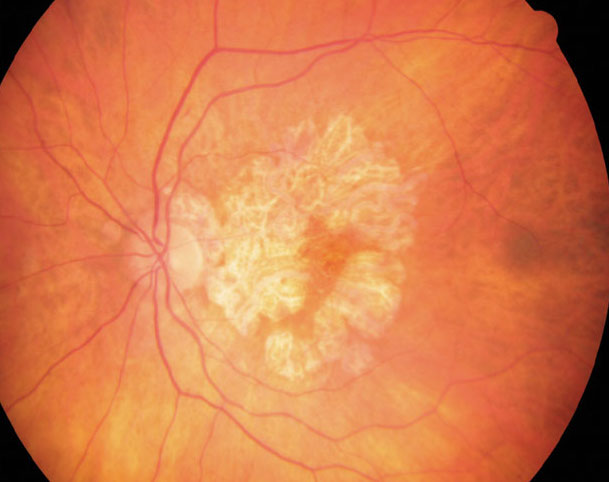 |
| The presence of choroidal hypertransmission defects could predict GA formation. Click image to enlarge. |
Once age-related macular degeneration (AMD) progresses into its late stage, geographic atrophy (GA), a patient’s loss of visual function becomes irreversible. Detecting the progression of AMD through the measurement of clinical biomarkers is crucial to help preserve vision and maintain better quality of life in these patients.
There are two precursor lesions research has shown may predict GA development or enlargement: nascent GA and incomplete RPE and outer retinal atrophy. Since choroidal hypertransmission defects (hyperTDs) are a characteristic of both, investigators of a recent study decided to review these lesions in AMD patients using en face OCT to determine their association with disease progression and GA.
A total of 190 eyes with intermediate AMD were included in the study (mean age: 78). Each subject underwent 6x6mm SS-OCT raster scans at baseline and throughout the follow-up period (31 months on average). En face images were generated using a sub-RPE slab, which displays hyperTDs as bright regions that can be measured more easily. Segmentation boundaries on the slab were positioned at 64µm and 400µm beneath Bruch’s membrane. Two graders evaluated the images, flagging any hyperTDs with a greatest linear dimension (GLD) of ≥250µm and assessing patients for GA if such lesions were detected.
At the final follow-up, 24 of the 25 eyes that had progressed to GA had a prior hyperTD ≥250µm that was detected before the formation of GA. When the investigators performed a Cox survival regression analysis, the results estimated that once a hyperTD ≥250µm appears, patients have an 80-fold increased risk of developing GA.
“By 36 months,19% of all eyes had developed GA from baseline, while 61.9% of eyes with prior hyperTDs ≥250µm developed GA within 36 months after the first hyperTD was seen,” the study authors wrote. “In eyes without hyperTDs ≥250µm at baseline or follow-up, the cumulative proportion of all iAMD eyes developing GA was 1.3%.”
In conclusion, the study authors reported that “persistent choroidal hyperTDs, defined as having a GLD ≥250µm on sub-RPE en face OCT images, were a strong predictor of GA formation.” Consider using the en face imaging method to observe for this biomarker and evaluate AMD patients at risk for progression.
Laiginhas R, Shi Y, Shen M, et al. Persistent hyper-transmission defects detected on en face swept source oct images predict the formation of geographic atrophy in AMD. Am J Ophthalmol. November 1, 2021. [Epub ahead of print]. |

